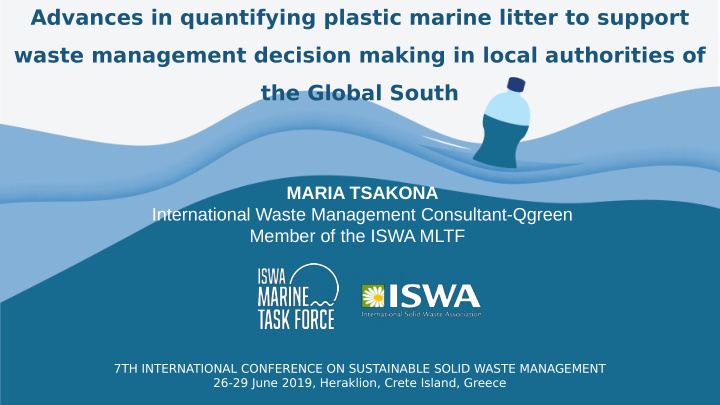



Advances in quantifying plastic marine litter to support waste management decision making in local authorities of the Global South MARIA TSAKONA International Waste Management Consultant-Qgreen Member of the ISWA MLTF 7TH INTERNATIONAL CONFERENCE ON SUSTAINABLE SOLID WASTE MANAGEMENT 26-29 June 2019, Heraklion, Crete Island, Greece
A GLOBAL CHALLENGE University of Minnesota stud
• About 300 M tonnes of plastic waste is generated annually • 9% is recycled -12% incinerated and the rest disposed in dumpsites/landfjll sites • 8-10 M tonnes of plastics escape into the ocean every year • 5 trillion items of microplastics getting into the sea every 60 - 90% of marine litter is plastic (UNEP- minute. 80% of marine litter from on land- GRID 2016) based sources The problem… in numbers
Source: https://www.breakfreefromplastic.org/2018/10/11/branded- pollution/
1 2 billion people without acess to solid waste collection INSUFFICIENT INFRASTRUCTURE What is wrong? 2 3 MARKETS FOR KNOWLEDGE SECONDARY GAPS MATERIALS GLOBAL SYSTEMIC FAILURES
Most of the plastic escapes from the Global South • Low collection coverage • Irregular collection services • Illegal open dumping • Open burning • Informal activities • Contaminated plastic scrap from countries of the Global North • Low- tech recycling units • Fewer trained people • Lack of political stability & environmental law enforcement An estimated 3.2m tonnes • Disarticulated economies of plastic polluted Indonesian waters in 2010
What do we need ? • Master plans on municipal, regional and national level to prevent and tackle marine litter • Scientific proven tools
Methodology The tool has been developed using Microsoft Excel taking into account: - Sources - Factors that afgect the location and quantity of potential plastic leakage - T ransfer coeffjcients to model transfer of plastic from source to fjnal receptors - Global scientifjc experience
Combined with CVORR The tool has the capability to expand to quantifjcation of loss of “value” present in waste plastics via combination with the Complex Value Optimization and Resource Recovery (CVORR) approach (Iacovidou et al., 2017) This approach assesses how value is created and destroyed in resource recovery from waste systems. It achieves this by taking into account environmental, economic, social and technical positive and negative impacts within the socio- political context of the specifjc regions.
Data-Required
It estimates…
Results you get…
Customised solutions…
POLICY/ INTERVENTIONS WITHIN THE TOOL ENGINEERING 23 T ake no action 3 Provide all households with waste 136 collection services T onnes/ye Increase collection frequency 114 ar 95 Engage with residents to tackle littering and dumping 77 Enclose storm drains
CREATE SCENARIO REVIEW IDENTIFY RESULT INTERVENTIONS THE CONTINUOUS IMPROVEMENT CYCLE RUN PRIORITISE THE TOOL INTERVENTIONS
Run case studies to expand database Validate Come alongside us! Partnership NEXT STEPS...
http://marinelitter.iswa.org/ marinelitter@iswa.org Get in touch: maria.tsakona@qgreen.gr
Recommend
More recommend